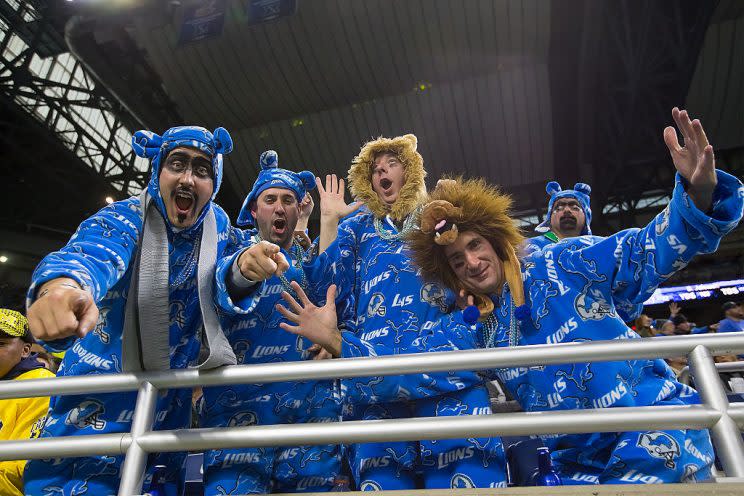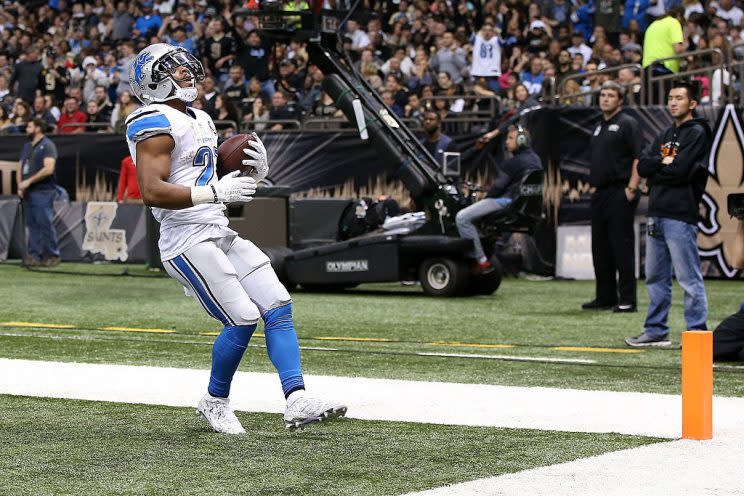Juggernaut Index, No. 25: Detroit is a PPR fantasy buffet

The Detroit Lions offense appears to have been created by and for fantasy owners in PPR leagues. If you like short passes to short players for short gains, this is your squad. If instead you have a preference for yards and points and deep strikes to dynamic playmakers, then perhaps you should look elsewhere. The Lions aren’t for everyone.
[Fantasy Football is open! Sign up now]
Matthew Stafford enters his ninth NFL season having made clear and meaningful strides in recent years. Without question, his quality of play has improved in the Jim Caldwell era, with Jim Bob Cooter on the coaching staff. Stafford’s average yards per attempt has increased from the early gunslinging years and his interception rate has dropped. He hasn’t approached the 5,000-yard plateau under Caldwell, but that’s OK (at least in real-life, if not in fantasy). He remains a relatively high-volume passer — Detroit has averaged 610 attempts per season since 2014 — while limiting his giveaways. Stafford established career lows in both interceptions (10) and fumbles (3) last year. He’s also led the NFL in game-winning drives in two of the past three seasons.
Still, it seems strange that Detroit relies so little on Stafford’s one indisputable elite skill, his almost mythic arm strength. When Stafford dials it up, the ball explodes from his hand. Even by NFL standards, his arm is rare.
But if we review the NFL leaders in deep throws and air-yards per attempt, Stafford’s name is buried near the bottom of the list. Last year, 16 different starting QBs averaged at least 4.5 deep balls per game, per Player Profiler. Ben Roethlisberger topped the list at 6.4. Stafford and his Death Star arm averaged 4.0. Kirk Cousins led all QBs in air-yards per attempt at 5.2. Stafford averaged just 3.6 — slightly behind Case Keenum (3.7) and slightly ahead of Alex Smith (3.4).
While this wouldn’t seem like the best possible use of Stafford’s talent, we again have to acknowledge that he’s had three very good seasons under his current coaches. In his worst years as a pro, his reckless, extreme reliance on arm strength did not serve him well. The Lions have made the playoffs in two of the past three seasons, so something is definitely working. Fantasy owners just need to understand that the 2011 version of Stafford (5038 yards) has been largely schemed away, and he isn’t coming back.

Golden Tate is, in fact, a PPR legend.
I cannot dispute the fact that in fantasy’s worst scoring format, Tate is a huge asset. He’s caught at least 90 balls in each of his three seasons in Detroit. He’s not exactly a yardage or touchdown machine, but I realize the PPR community doesn’t care about such things. Hooray, receiver screens. Hooray, short slants.
Tate is just a year removed from a 90-catch, 813-yard season, which is the sort of stat line you’d expect from a running back, not a wideout. Only nine receivers or tight ends in NFL history have ever caught 90 or more passes and gained less than 1000 yards; only Tate and Troy Brown have finished with less than 900 on as many catches. But, again, the PPR people aren’t bothered by this. Tate is clearly a format dependent player. Draft him as an uninteresting WR3 in standard and a high-end WR2 in PPR.
Marvin Jones returns for his second year in Detroit, coming off a season that began with fireworks and ended in ignominy. In Jones’ first four games, he gained 482 yards and reached the end-zone twice. In all remaining games, he delivered just 448 yards with two scores. The final eight weeks were particularly useless: 19 receptions, 274 yards, zero TDs. He was never going to sustain his September pace last season, but it’s amazing he couldn’t reach 1000 yards after his blistering start.
Jones is still only 27 years old and he spent a portion of his offseason training with Randy Moss, for what it’s worth. It’s not unreasonable to hope for another 900-or-so yards from Jones in 2017, with a modest increase in touchdowns. He remains an unchallenged starter. Just keep in mind that he’s tied to a horizontal-strike offense, not a team that regularly looks to stretch the field.
Third-round rookie Kenny Golladay has earned nothing but glowing reports during the offseason, and, given this team’s lack of receiver depth, he should immediately see the field. He’s a tall receiver (6-foot-4) with long arms and excellent timed speed for a player his size (4.5 at 220 pounds). Golladay is coming off back-to-back 1100-yard seasons at Northern Illinois. Anquan Boldin is out of the mix in Detroit this season, leaving a path to sneaky red-zone fantasy relevance for Golladay.
Eric Ebron enters his fourth season coming off career highs in receptions (61), targets (86) and receiving yards (711). Boldin’s departure could, in theory, mean big things for Ebron. Last year, Anquan ruled the red-zone for the Lions, drawing 23 targets inside the 20-yard line and 11 inside the 10. Ebron saw only six and three in the same areas. Detroit added blocking specialist Darren Fells in the offseason, which helps presumably Ebron as well. It’s not uncommon for tight ends to develop late, or in their second contracts, so we shouldn’t completely give up on the former No. 10 overall pick. Health has of course been an issue for Ebron; he hasn’t yet played a full 16-game season. But with a Yahoo ADP of 123.1, it’s easy to look past the negatives and see the upside here.
Is this where you try to sell us on Ameer Abdullah for a third straight season?
Yup, ‘fraid so. But perhaps less forcefully than in prior years.
Detroit didn’t make a significant addition to its backfield depth chart during the offseason, which we have to interpret as a vote of confidence in Abdullah. A foot injury limited him to just a game and a half last season, but he looked just fine when he played: 18 carries, 101 yards, five catches for 57, TD. Abdullah generated plenty of buzz during OTAs, reestablishing himself as this team’s best dual-threat back, by a wide margin. Don’t even come at me with Theo Riddick and Zach Zenner.

Sure, Riddick has a gift for catching the short, quick-hit passes that define this team’s offense. He’s averaged 6.4 targets and 5.1 receptions per game for the Lions over the past two seasons. Even more than Tate, Riddick is treated as a minor god by the PPR community. He’s not a particularly gifted runner, having averaged just 3.5 YPC for his career and 3.9 last season. Zenner is totally serviceable, but he lacks Abdullah’s suddenness and ability to make defenders whiff. Zenner is the biggest back in this trio, so we can’t rule out a goal-line role. But Abdullah clearly enters the season as the featured guy, and deservedly so. Riddick underwent surgery on both wrists in the offseason, so we may not see much of him early in camp.
To me, Abdullah seems like a gift at his ADP (100.8). He’s going six picks later than Jeremy Hill, who is terrible. He goes forty five picks after C.J. Anderson, a player he could easily outproduce. Take a flier on Abdullah. He’s practically free in drafts.
One not-so-minor concern: Detroit’s O-line didn’t grade out well last season, and LT Taylor Decker seems likely to miss the first half of the season following shoulder surgery. It’s a worry for both the running game and the offense as a whole.
Any reason to invest in Detroit’s team defense?
Well, the team’s first-half schedule is no picnic: Ari, at NYG, Atl, at Min, Car, at NO, bye, Pit, at GB. It’s tough to find a favorable matchup until November, so you can’t realistically draft this group. Detroit’s defense was a middle-of-the-pack unit that didn’t generate many takeaways (14) or sacks (26) last season. I can’t build a strong case for this unit as a top-20 fantasy D.
2016 Offensive Stats & Ranks
Points per game – 21.6 (20)
Pass YPG – 256.9 (11)
Rush YPG – 81.9 (30)
Yards per play – 5.5 (17)
Plays per game – 60.6 (29)
—
Previous Juggernaut Index entries: 32) NY Jets, 31) San Francisco, 30) Cleveland, 29) LA Rams, 28) Baltimore, 27) Chicago, 26) Minnesota, 25) Detroit



